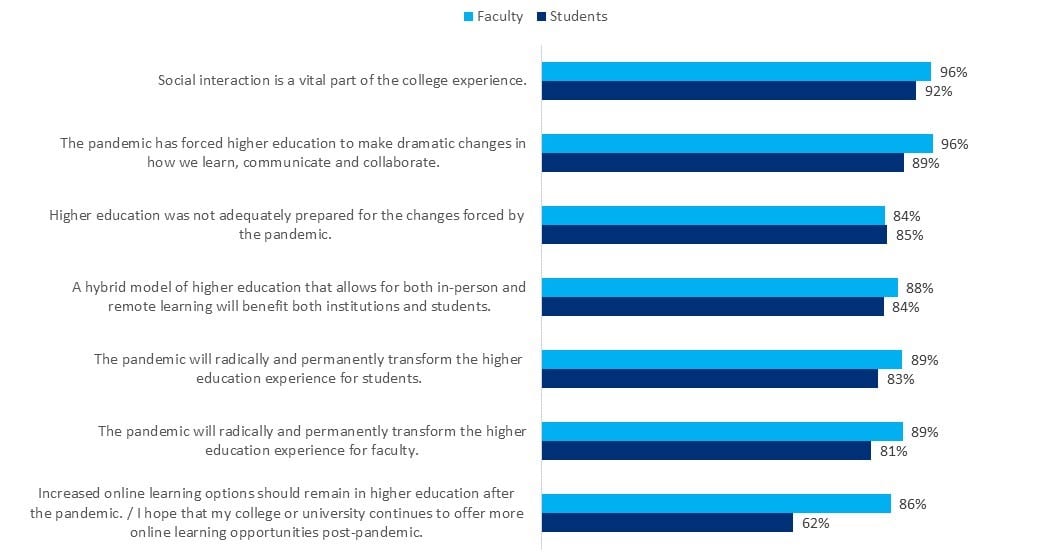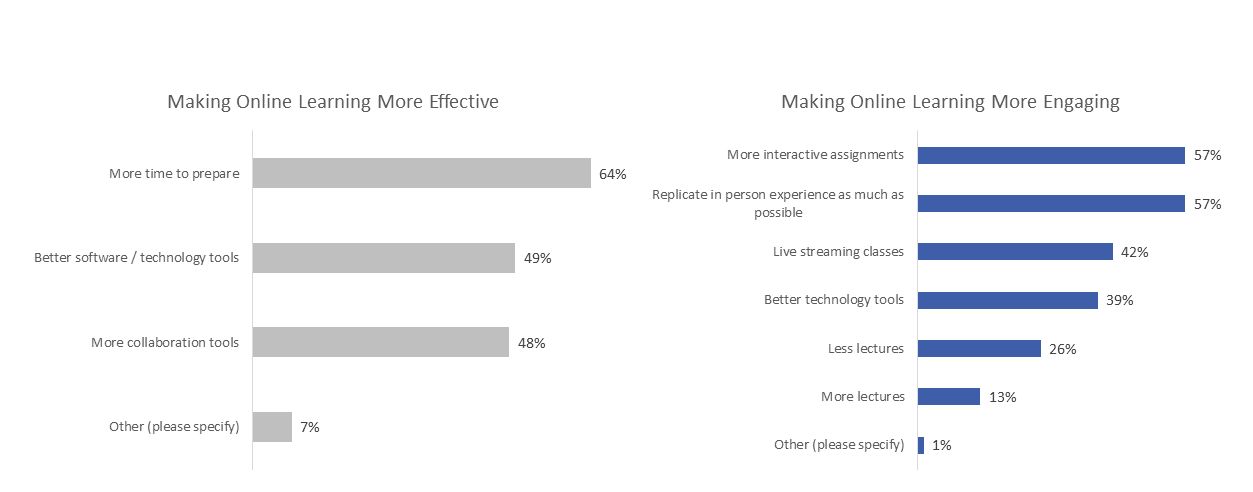Social interaction is the missing link in distance learning as 66% said it’s what they miss most about the in-person classroom experience, 57% of students said they would prefer more interactive assignments
When COVID-19 struck, universities all over the country scrambled to deploy remote learning resources as a way to minimize gaps in learning while also keeping students and staff safe. The results of the near-overnight shift were underwhelming for both students and faculty.
To learn more about the sentiment toward remote learning and what steps could be taken to improve it, RingCentral surveyed 1,000 current and incoming college students, along with 600 university faculty and staff across the U.S. The survey, executed by CITE Research, examined feelings about the remote learning experiences during Spring 2020 and the expectations around remote learning in the coming months. The key results of the survey are as follows:
- 83% of students and 89% of faculty believe that the COVID-19 pandemic will have a lasting impact on students in higher education students
- 67% of faculty believe online learning is effective for their students, yet 59% of faculty report that their students are less engaged while learning remotely
- Lack of social connection is rated the most challenging part of online learning with 87% of students saying it is a challenge
- Vast majority of faculty (85%) and students (81%) like the flexibility of digital learning for students
Now, as colleges and universities begin to welcome students back to what will be predominantly online campuses, educators continue to grapple with the balance of in-person learning against the safety of students, staff, and employees. The RingCentral study provided the opportunity for participants to offer suggestions about how to better integrate remote learning into the educational experience. Overall, they’re looking for some semblance of normalcy that will do a better job of facilitating learning, collaborating, and socializing with peers similar to what was provided through an in-person classroom setting.
In terms of effectiveness, there was a noticeable gap between students and faculty, as 67 percent of faculty but only 51 percent of students thought their digital learning experience was “effective” thus far, with 59 percent of teachers noting that students seemed less engaged in online classes. But they also understand the long-term impact. A much larger percentage—83 percent of students and 89 percent of faculty—said that the pandemic will have a lasting impact on higher education and that learning experiences will be different in the future.
Agreements with Statements (Somewhat + Strongly Agree)

Improved collaboration—find the missing link
The lack of social engagement in school was one of the biggest drivers of negative sentiment around remote learning in the Spring. Nearly half of the surveyed students (47 percent) said socializing was the thing they missed the most about in-person learning, while 66 percent ranked socialization as one of the main things they missed most about the college experience.
Students believed that a better way to replicate the in-class experience was to improve virtual collaboration and interaction with other students. To that point, 59% of faculty said their students were less engaged during the pandemic than before.
So it is no surprise that well over half (57 percent) of students said they would prefer more interactive assignments. The same number of students are hoping that technology, among other means, can help replicate that in-person experience.

Simplify and unify the technology
Certainly, the rush to launch online learning in the Spring led to a scatter-shot approach for introducing new software and other forms of technology to facilitate digital learning. On average, schools used 3 or more different tools to facilitate online learning—tools that mostly fell short of student expectations.
As schools look at new offerings, they must seek out integrated solutions that allow students and staff to work from their application of choice and have access to resources provided by a single platform. A unified solution will enable a seamless workflow experience as students and teachers continue to adjust to distance learning.
To that end, nearly half of all students (48 percent) said they’d like better software collaboration tools. And the faculty wholeheartedly agree with nearly all of them (98 percent) are interested in integration between video conferencing and the learning management system, with especially high interest in single sign-on, direct scheduling, and automatic recording. 
Remote learning: It’s here to stay
Despite the issues with online learning, the majority of students (57 percent) and faculty (85 percent) are interested in remote learning post-pandemic. And even though social interaction is vital to the classroom experience, this isn’t stopping students from attending classes remotely. 81 percent of returning students (rising sophomores, juniors, and seniors) and 73 percent of prospective students said they plan to attend remote classes in the fall. Yet, there is clearly room for improvement as majorities of both groups—64 percent of students and 58 percent of faculty—believe that a better virtual experience requires more time to prepare.
The key is how these changes are made. With education costs escalating and remote learning expected to play a significant role in most university experiences for the foreseeable future, students are demanding—and universities are looking for—improvements to the remote learning experience through technology that can enhance student engagement.
Despite their disappointment in their previous experiences, 81 percent of students do find the flexibility of remote learning beneficial. And, with many schools planning to provide some form of online learning this fall, implementing some of the technological and structural changes that students and faculty are seeking will go a long way in keeping everyone learning, happy and safe.
Before the start of the semester ahead, education institutions should look to connect and collaborate with their instructional technology partners for their support and assistance with developing both in-person and remote learning materials for students and faculty. This is a critical step for a highly engaging new semester that leverages the technology in the best way possible for an effective and enjoyable remote learning experience for faculty and students alike.
To learn more, read my blog post featuring tips on how to create an effective remote learning environment.
And for additional RingCentral resources, check out these links as well:
- Canvas integration
- Coursera case study https://www.ringcentral.com/whyringcentral/casestudies/coursera.html
- How best to run an online class
Originally published Aug 19, 2020, updated Oct 26, 2021





